In the competitive B2B SaaS market, understanding your rivals isn't just a good practice; it's a fundamental requirement for survival and growth. Guesswork about their marketing strategies, product updates, and customer acquisition channels can lead to missed opportunities and wasted resources. The right competitor analysis tools transform this guesswork into a data-driven strategy, giving you a clear view of the landscape and a roadmap to outmaneuver the competition. Without them, you're essentially flying blind, unable to anticipate market shifts or react effectively to a competitor's successful campaign.
This guide is built to cut through the noise. We've compiled a comprehensive list of the best competitor analysis tools specifically curated for B2B SaaS professionals. We skip the generic marketing fluff and dive straight into what matters: practical applications, honest limitations, and specific use cases. Whether you need to deconstruct a competitor's SEO and backlink profile, monitor their content marketing effectiveness, or track their feature releases and pricing changes, you'll find a solution here tailored to that exact need.
Each entry provides a detailed breakdown, including screenshots and direct links, to help you make an informed decision quickly. You will learn how to leverage platforms like Semrush and Ahrefs for deep SEO insights, use tools like Crayon and Klue for real-time competitive intelligence, and uncover the tech stacks of your rivals with BuiltWith. Our goal is to equip you with the information needed to select the perfect toolset that aligns with your specific strategic objectives, budget, and team size, turning competitive data into your most powerful asset.
1. Semrush
Semrush is an all-in-one digital marketing and SEO suite that has become a cornerstone for many B2B SaaS marketers. It provides a massive repository of competitive intelligence, making it one of the best competitor analysis tools available for a holistic view of your rivals' digital footprint. Its real power lies in unifying data from organic search, paid ads, content marketing, and backlink profiles into a single, interconnected dashboard.
You can start by simply entering a competitor's domain to uncover their top organic keywords, see the ad copy they are running, and analyze their backlink portfolio. This allows you to reverse-engineer their most successful strategies. For example, a SaaS marketer could use the Keyword Gap tool to find high-value keywords their competitors rank for, but they don't, instantly revealing new content opportunities.
The platform's Traffic Analytics and Market Explorer add-ons elevate its capabilities from simple domain analysis to true market intelligence. These features provide insights into competitors' website traffic sources, audience demographics, and overall market share, helping you benchmark your performance against the entire industry landscape.
Key Features & Use Cases
- Competitive SEO Analysis: Use the Domain Overview to dissect a rival’s organic traffic, keyword profile, and backlink authority. Identify their top-performing content and keywords to inform your own SEO strategy.
- PPC Intelligence: Analyze competitors' Google Ads strategies, including their ad copy, keywords they are bidding on, and estimated monthly spend. This is invaluable for refining your own paid campaigns and identifying budget-wasting keywords to avoid.
- Backlink Gap Analysis: Find websites linking to your competitors but not to you. This creates a high-priority list of outreach targets for building your domain authority.
- Content Marketing Insights: Use the Topic Research tool to see what content resonates in your niche and analyze the structure and SEO performance of top-ranking articles.
Pros & Cons
Pros:
- Comprehensive Data: Offers an incredibly deep and broad dataset across SEO, PPC, and content.
- Integrated Workflow: All tools work together, allowing for a seamless transition from one analysis to another.
- Powerful Reporting: Features robust reporting tools, including integrations with Looker Studio and white-label options for agencies.
Cons:
- Steep Learning Curve: The sheer volume of tools and data can be overwhelming for beginners.
- Costly Add-ons: Key features like Traffic Analytics and Market Explorer come at an additional cost, which can make the platform expensive.
Website: https://www.semrush.com
2. Ahrefs
Ahrefs is a powerhouse SEO platform renowned for its colossal backlink index and granular keyword data, making it an indispensable tool for deep-dive competitor analysis. While Semrush offers a broader marketing suite, Ahrefs focuses intensely on providing best-in-class SEO intelligence. Its core strength lies in its ability to meticulously deconstruct a competitor's organic search performance, from their most valuable backlinks to their historical keyword rankings.

For a B2B SaaS marketer, Ahrefs' Site Explorer is the perfect starting point. By entering a competitor’s domain, you can immediately access a detailed breakdown of their backlink profile, top organic pages, and paid search activities. The platform’s Content Gap feature is particularly potent, allowing you to compare your domain against multiple competitors simultaneously to find keywords they all rank for, but you don't. This creates a data-driven roadmap for your content strategy.
Ahrefs continues to innovate with features that align with modern SEO practices. Its evolving tools are becoming more sophisticated, incorporating aspects of AI in search engine optimization to provide deeper insights. The platform’s clean interface and fast data processing make complex analysis feel surprisingly accessible.
Key Features & Use Cases
- Backlink Profile Analysis: Use Site Explorer to view a competitor's complete backlink profile, identify their highest-authority referring domains, and spot link-building patterns you can replicate.
- Content Gap Identification: Discover keywords that your competitors rank for but you miss. This is a goldmine for finding new blog topics and landing page ideas with proven demand.
- SERP History: Analyze the historical ranking data for any keyword to understand volatility and see which competitors have consistently held top positions over time.
- Top Pages Analysis: Find out which of your competitor's pages generate the most organic traffic. This helps you understand their most successful content formats and topics.
Pros & Cons
Pros:
- Industry-Leading Link Index: Widely considered to have one of the most comprehensive and up-to-date backlink databases available.
- Excellent User Interface: The platform is fast, intuitive, and presents complex data in an easy-to-digest format.
- Robust SERP History Data: Provides unique insights into keyword ranking fluctuations and long-term competitor performance.
Cons:
- Pricing Model: It can be expensive for smaller businesses, and key features like daily rank tracking updates require paid add-ons.
- Focus is Primarily SEO: While excellent for SEO, it lacks the broader digital marketing features found in all-in-one suites like Semrush.
Website: https://ahrefs.com
3. Similarweb
Similarweb is a digital intelligence platform that excels at providing a high-level, market-wide view of web and app traffic. While tools like Semrush focus heavily on search-centric data, Similarweb’s strength lies in its ability to analyze a competitor’s entire digital ecosystem, including direct, referral, social, and display ad traffic sources. This makes it one of the best competitor analysis tools for understanding market share and a rival's complete channel mix.
The platform allows you to benchmark your performance against specific competitors or an entire industry category. A B2B marketer could use it to see which social media platforms drive the most traffic for their rivals, or analyze the geographic distribution of a competitor's audience to inform international expansion plans. Its data provides a strategic overview that helps answer bigger questions about market positioning and audience behavior.
Similarweb's interface is highly visual and focused on top-line metrics, making it easier to grasp complex data quickly. The platform provides estimated traffic numbers, engagement rates, and audience demographics, offering a powerful snapshot of any company's digital presence and helping you identify new market trends and opportunities.
Key Features & Use Cases
- Traffic & Engagement Analysis: Gain insights into a competitor’s website traffic volume, traffic sources (direct, search, social, etc.), and on-site engagement metrics like bounce rate and session duration.
- Audience Intelligence: Understand a competitor’s audience demographics and interests, helping you refine your own target personas and marketing messages.
- Channel & Geo Breakdown: Analyze a competitor’s marketing channel mix and identify which countries are driving the most traffic to their site.
- Industry & Market Analysis: Benchmark your website's performance against the industry average to understand your market share and identify growth opportunities.
Pros & Cons
Pros:
- Strong Market-Level View: Excellent for market sizing, category benchmarking, and analyzing a competitor's complete channel mix.
- Broad Traffic Source Data: Provides data beyond organic search, including direct, referral, and social traffic.
- User-Friendly Interface: Presents complex data in an intuitive, visually appealing way.
Cons:
- Data is an Estimate: Traffic and engagement metrics are estimations, not exact figures, and may have discrepancies.
- Enterprise-Focused Pricing: Advanced features and deeper data are locked behind expensive enterprise plans, making it less accessible for smaller businesses.
Website: https://www.similarweb.com
4. SpyFu
SpyFu is a highly specialized competitor analysis tool with a laser focus on search marketing intelligence. For B2B SaaS marketers who need to deconstruct their rivals' SEO and PPC playbooks, SpyFu provides an incredibly rich historical dataset. It stands out by allowing you to essentially download a competitor's most profitable keywords and ads from both Google Ads and organic search, spanning over a decade of data.
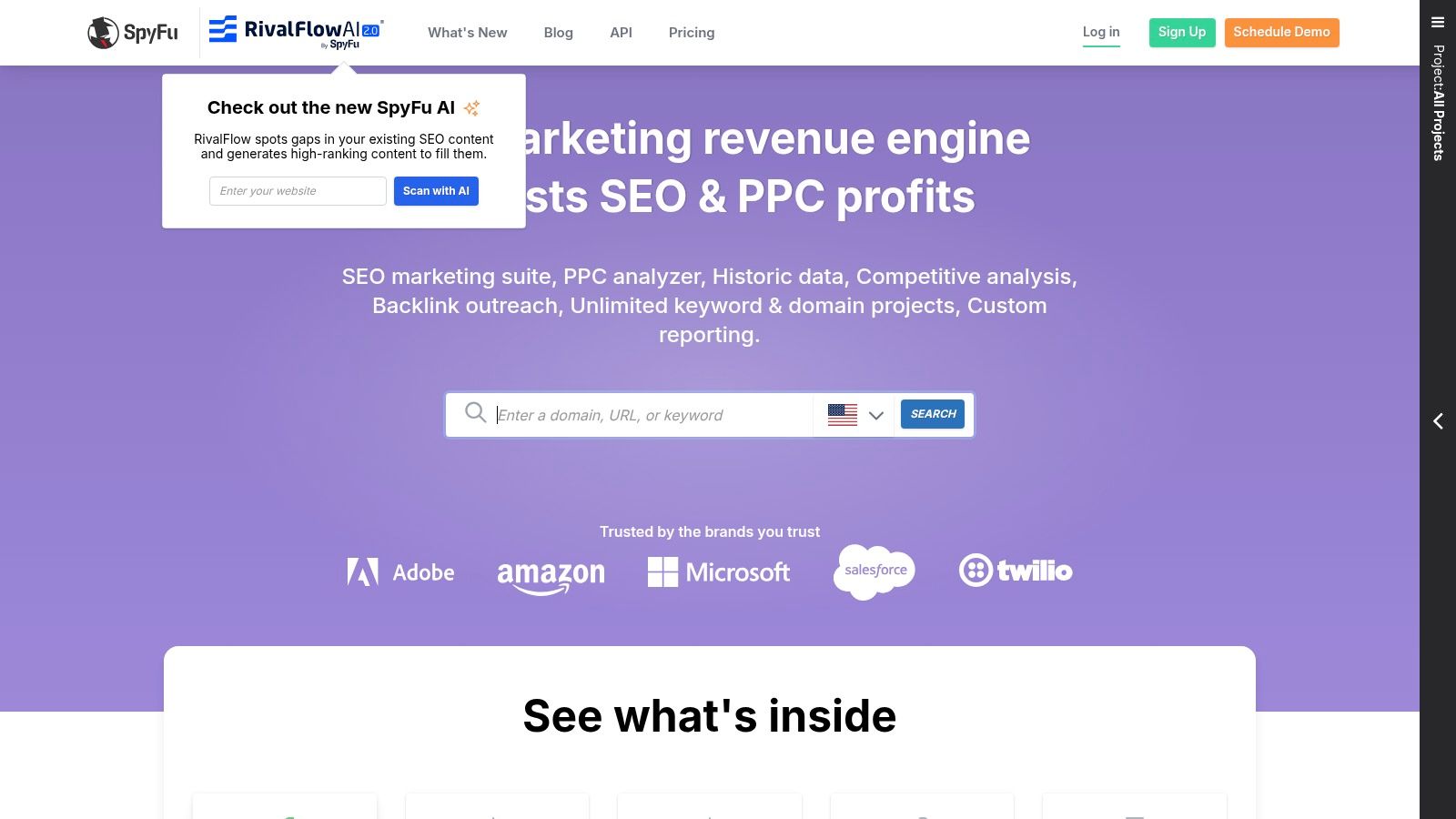
Unlike broader suites, SpyFu is built for search-centric reconnaissance. You can enter a competitor's domain and immediately see every keyword they've ever ranked for, every ad they've tested, and their estimated ad spend history. The platform’s Kombat tool is particularly powerful, allowing you to compare your domain against two competitors to find "weakness" keywords, those that your competitors rank for but you don't. This makes it one of the best competitor analysis tools for direct, actionable search insights.
Key Features & Use Cases
- PPC Competitor Research: Uncover a competitor's complete Google Ads history. See their ad variations, keyword choices, and estimated monthly budget to find profitable campaign ideas and avoid costly mistakes.
- SEO Competitor Analysis: Identify the exact organic keywords that drive traffic to your competitors. Analyze their ranking history to understand their content strategy's long-term effectiveness.
- Domain & Keyword "Kombat": Pit your domain against two others to find shared keywords and, more importantly, exclusive keywords your competitors are targeting that you've missed.
- Backlink Outreach: Find specific backlinks that are helping your competitors rank for certain keywords, creating a targeted list for your link-building campaigns.
Pros & Cons
Pros:
- Clear and Detailed PPC Intelligence: Offers some of the most granular historical data on Google Ads campaigns available.
- Unlimited Searches & Exports: The Pro plan offers unlimited data exports, a major advantage over credit-based systems.
- Good Price-to-Value Ratio: Provides deep search intelligence at a more accessible price point for SMBs compared to enterprise suites.
Cons:
- Less Comprehensive Scope: The interface and depth of data are not as extensive as all-in-one platforms like Semrush or Ahrefs.
- Variable Data Depth: The historical data depth can vary depending on the specific dataset and plan you are on.
Website: https://www.spyfu.com
5. BuzzSumo
BuzzSumo is a content marketing and digital PR platform that excels at revealing what content performs best for any topic or competitor. Instead of focusing on technical SEO metrics, it zeroes in on social engagement, backlink authority, and content trends, making it one of the best competitor analysis tools for content-led strategies. Its core strength is its ability to instantly show you the most shared and linked-to content across your entire industry.
By entering a competitor's domain, you can see a ranked list of their most successful articles, blog posts, and landing pages from the past year. This allows a B2B SaaS marketer to identify their rivals' top-performing content formats and topics, uncovering patterns that can be adapted for their own content calendar. This type of analysis is a key pillar of effective digital marketing for SaaS companies, as it helps de-risk content creation by focusing on proven concepts.
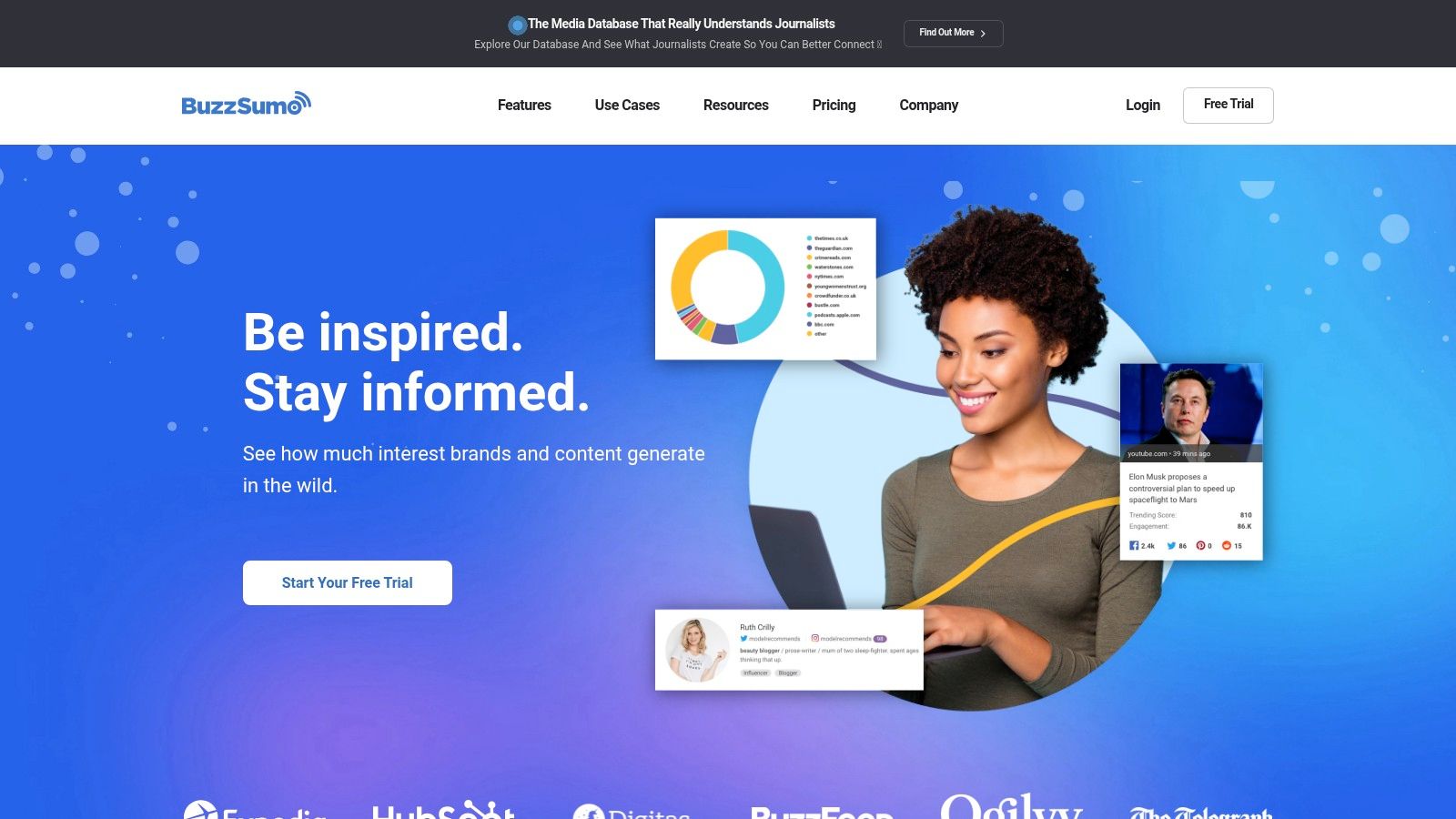
The platform also includes robust media monitoring and author tracking. You can set up alerts to get notified whenever a competitor is mentioned online or publishes new content, allowing you to react quickly. This feature is particularly useful for digital PR, as you can identify journalists and influencers who are already covering your competition.
Key Features & Use Cases
- Content Analyzer: Discover your competitors' most shared and linked-to content to identify successful topics, formats, and headlines. This is perfect for brainstorming blog posts that have a high probability of success.
- Topic & Question Research: Use the Question Analyzer to find real questions people are asking online related to your niche, providing direct inspiration for FAQ pages, help docs, and problem-focused content.
- Media Monitoring & Alerts: Set up real-time alerts for competitor brand mentions, keyword mentions, or new content from specific domains to stay on top of their PR and marketing activities.
- Influencer & Journalist Search: Find key authors, journalists, and influencers who have written about your competitors or industry topics, creating a targeted list for outreach campaigns.
Pros & Cons
Pros:
- Excellent for Content Ideation: Unparalleled for finding proven content ideas and trending topics quickly.
- Strong Digital PR Focus: The journalist database and monitoring tools are fantastic for PR and link-building outreach.
- User-Friendly Interface: The platform is intuitive and easy to navigate, even for beginners.
Cons:
- Limited SEO Data: It is not a comprehensive SEO tool; it lacks features like rank tracking or technical site audits.
- High Entry Price: The pricing can be steep for small businesses or freelancers focused solely on content research.
Website: https://buzzsumo.com
6. Owler
Owler is a community-driven business intelligence platform that excels at providing high-level company data and real-time news alerts. While not a traditional SEO or PPC tool, it's one of the best competitor analysis tools for sales, marketing, and business development teams who need to monitor rivals' corporate health, funding rounds, acquisitions, and leadership changes. Its power lies in crowdsourcing data to keep company profiles fresh and dynamic.
You can create a "watchlist" of competitors to receive automated alerts on significant events, like a new funding announcement or a key executive hire. This allows you to stay ahead of market shifts and react quickly to competitive threats or opportunities. For a B2B SaaS marketer, this could mean identifying a competitor's expansion into a new market or a potential weakness following a leadership shake-up, providing timely intelligence for strategic pivots.
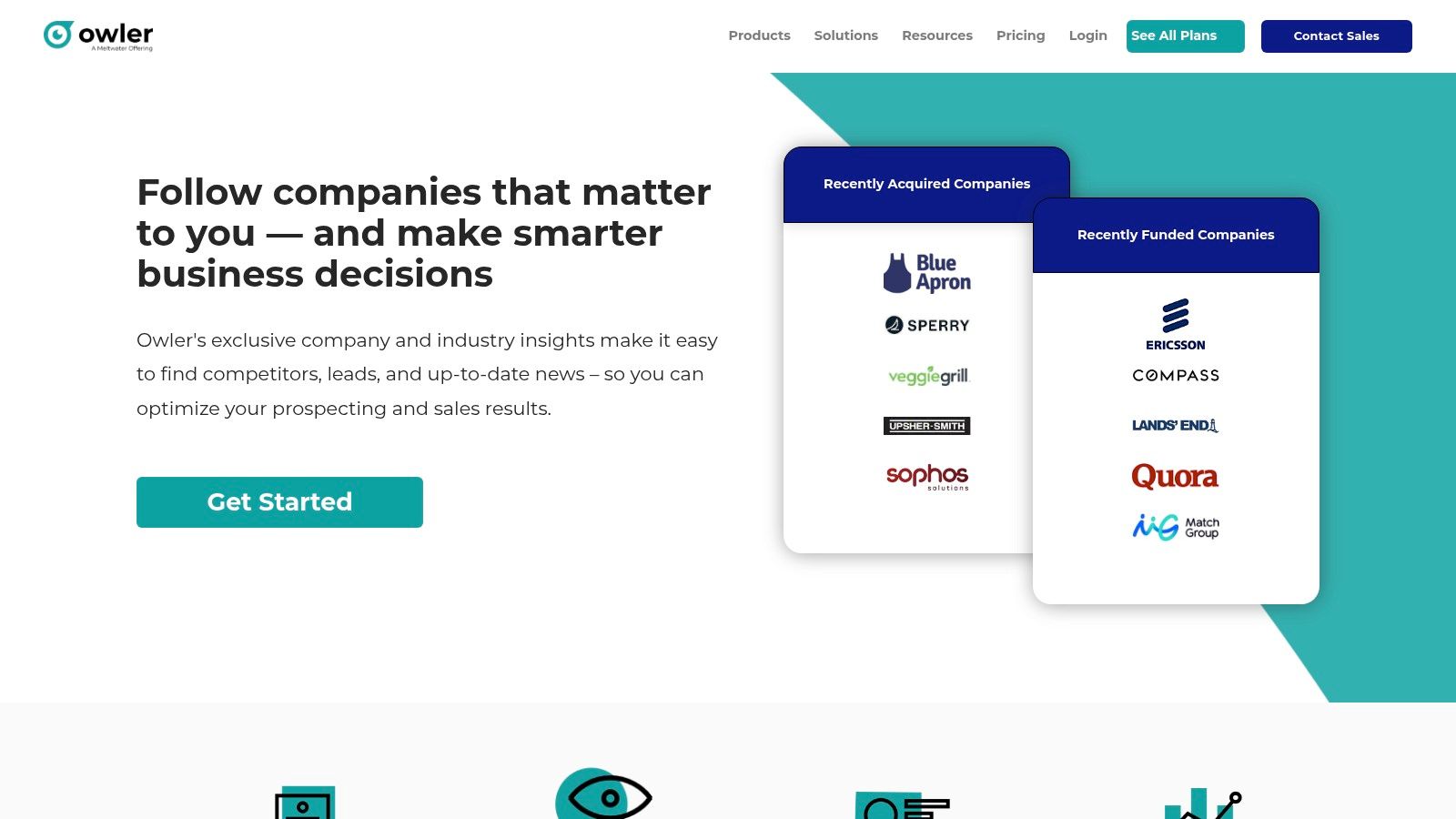
The platform maps out competitive landscapes, showing you a company’s top three direct competitors based on community input. This feature is invaluable for quickly understanding your position within a specific niche and discovering emerging players you may not have been aware of, making it a crucial tool for ongoing market awareness.
Key Features & Use Cases
- Competitor Watchlists: Create and monitor custom lists of competitors to receive daily or weekly digests on news, press releases, and blog updates.
- Instant Insights: Get real-time alerts on 16 unique trigger events, including funding, acquisitions, and leadership team changes, to inform sales and marketing tactics.
- Company Profiles: Access detailed profiles that include annual revenue, employee count, top competitors, and recent company news.
- Advanced Search & Filtering: Build targeted lists of companies for account-based marketing (ABM) or sales prospecting based on industry, location, revenue, and other firmographic data.
Pros & Cons
Pros:
- Real-Time Intelligence: Excellent for timely updates on company news and corporate events.
- Sales & ABM Focus: Incredibly useful for business development and sales teams needing company-level insights for prospecting.
- Simple Interface: Easy to set up and manage watchlists for quick monitoring.
Cons:
- Opaque Pricing: Pricing and plan specifics are not readily available on the website, requiring contact with sales.
- Limited Digital Marketing Data: Lacks the deep SEO, PPC, and traffic analytics found in other dedicated tools.
Website: https://www.owler.com
7. Crayon
Crayon is a dedicated competitive intelligence platform built to move beyond simple data gathering and toward actionable, distributed insights. Where other tools provide raw data on SEO or ad spend, Crayon focuses on automating the collection and synthesis of a competitor’s complete digital presence, turning it into enablement materials for sales, marketing, and product teams. It excels at continuously monitoring everything from website changes and product updates to messaging shifts and customer reviews.
The platform is designed to serve as a central nervous system for competitive intelligence, tracking over 100 data types across the web. This continuous monitoring means teams are alerted to competitor moves in near real-time, not weeks later. For B2B SaaS companies, this means being able to quickly adapt sales pitches, marketing campaigns, and even your product roadmap based on what the competition is doing right now. The emphasis is on equipping teams, particularly sales, with the information they need to win more deals.
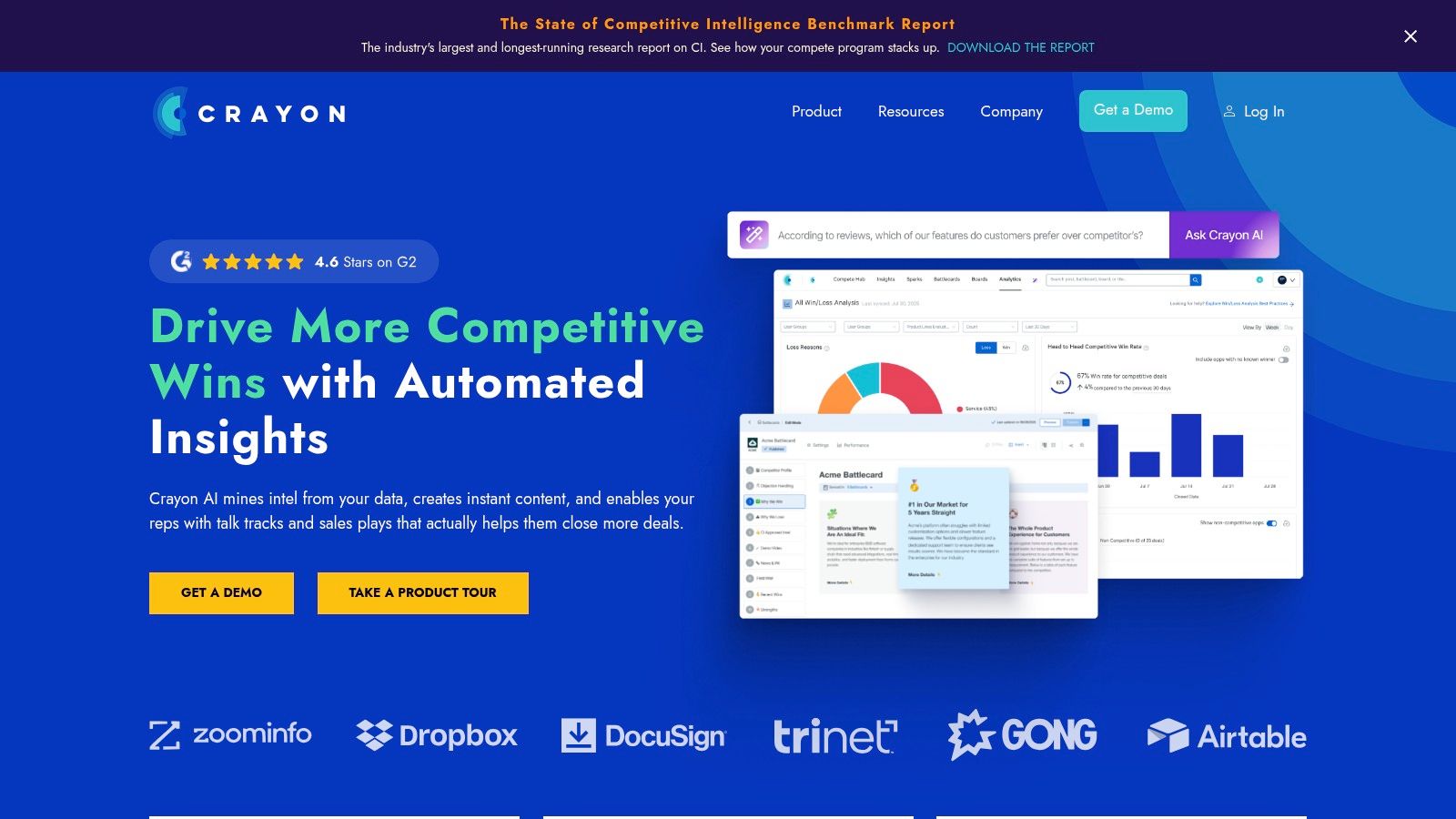
Crayon’s true power lies in its workflow and distribution capabilities. It’s not just about collecting data; it’s about creating and disseminating battlecards, win/loss reports, and market updates that are easily accessible to the entire organization. This transforms competitive analysis from a siloed marketing function into a company-wide strategic advantage, directly impacting revenue and market position.
Key Features & Use Cases
- Automated Intelligence Gathering: Continuously track competitor website changes, pricing updates, marketing campaigns, customer reviews, and more. This provides a holistic view that also contributes to your online reputation management guide.
- Sales Battlecard Creation: Build dynamic, data-backed battlecards that equip your sales team with key differentiators, objection handling points, and competitor weaknesses to use in live deals.
- Win/Loss Analysis: Integrate with your CRM to track competitive win/loss reasons, providing quantifiable data on why you are winning or losing against specific rivals.
- Cross-Functional Enablement: Distribute tailored intelligence reports and alerts to stakeholders in sales, marketing, product, and leadership via Slack, email, or the Crayon platform.
Pros & Cons
Pros:
- Purpose-Built for CI: Specifically designed for competitive intelligence workflows, unlike broader marketing suites.
- Strong Sales Enablement: Excellent tools for creating and distributing battlecards that directly impact revenue.
- Holistic Data Collection: Tracks a vast array of signals for a complete picture of competitor movements.
Cons:
- Enterprise-Focused Pricing: Lacks transparent pricing tiers, indicating a focus on larger, enterprise-level contracts.
- Requires Internal Adoption: The tool's value is heavily dependent on strong internal processes and team adoption to be effective.
Website: https://www.crayon.co
8. Klue
Klue is a competitive enablement platform designed to operationalize competitive intelligence, moving it from static reports into the daily workflows of sales and revenue teams. Unlike tools that focus solely on external data gathering, Klue specializes in collecting, curating, and distributing actionable intel to help salespeople win more competitive deals. It automates the collection of intel from millions of sources and uses AI to surface the most relevant insights.

The platform's core strength is its ability to create and maintain dynamic sales battlecards. These aren't just documents; they are living resources integrated into CRMs and communication tools like Slack, delivering timely talking points, objection handling tips, and competitor takedowns right when a sales rep needs them. This focus on "the last mile" of competitive intelligence makes it one of the best competitor analysis tools for directly influencing revenue.
Klue's integrations with CRM and win-loss analysis platforms close the loop, connecting market intel with actual deal outcomes. The introduction of its 'Compete Agent' AI further enhances this by allowing teams to ask natural language questions and receive instant, context-aware competitive answers, transforming how intel is accessed and used.
Key Features & Use Cases
- Automated Intel Collection: Gathers competitive information from sources like web pages, news alerts, and review sites, using AI to filter out noise and highlight critical updates.
- Dynamic Sales Battlecards: Create and distribute up-to-date competitive battlecards that are easily accessible within your team’s existing tools (e.g., Salesforce, Slack) to improve sales effectiveness.
- Win-Loss Program Integration: Connect win-loss data directly to competitor profiles to understand why you are winning or losing deals and identify patterns in your competitive landscape.
- Competitive Program Analytics: Track the usage and impact of your competitive content to measure ROI and prove the value of your competitive enablement program to stakeholders.
Pros & Cons
Pros:
- Enterprise-Ready Enablement: Excels at distributing intelligence at scale across large go-to-market organizations.
- Proven Revenue Impact: Directly designed to improve competitive win rates, with analytics to prove its effect.
- Deep Integrations: Seamlessly connects with the tools sales and marketing teams already use daily.
Cons:
- No Public Pricing: Requires engaging with their sales team for a custom quote, making it difficult to evaluate initial cost.
- Niche Focus: Best suited for mid-market and enterprise companies with dedicated competitive intelligence or product marketing functions.
Website: https://klue.com
9. BuiltWith
BuiltWith offers a unique angle on competitive intelligence by focusing exclusively on the technology stack that powers a website. It’s not an SEO or traffic analysis tool; instead, it provides deep technographic data, revealing what CRM, analytics, advertising, and content management systems your competitors are using. This insight is invaluable for B2B SaaS companies looking to understand a prospect's existing tech ecosystem or identify competitors' strategic technology investments.
By entering a competitor’s domain, you can see a detailed list of every detectable technology they have installed, from JavaScript libraries to hosting providers. This allows you to tailor your sales outreach and marketing messaging. For instance, if you see a competitor is using an outdated analytics tool, you can position your advanced analytics solution as a direct upgrade. The platform also tracks technology usage over time, showing when a competitor added or removed a specific tool.
This technology-first approach makes BuiltWith one of the best competitor analysis tools for go-to-market teams. It helps identify highly qualified leads based on the software they use, enabling hyper-targeted marketing campaigns and providing sales teams with crucial context before an initial conversation.
Key Features & Use Cases
- Technology Profile Analysis: Look up any competitor’s website to get a comprehensive list of the technologies they use, including advertising, analytics, e-commerce, and hosting platforms.
- Lead Generation: Generate lists of websites that use (or don't use) a specific technology. This is perfect for building targeted prospect lists for sales and marketing outreach.
- Market Share Reports: Analyze technology adoption trends to understand the market share of different software products within a specific vertical or geographic region.
- Historical Tech Data: Track when competitors adopt or drop certain technologies, providing clues about their strategic shifts, budget changes, or dissatisfaction with a vendor.
Pros & Cons
Pros:
- Valuable Technographic Data: Provides specialized insights that are hard to find elsewhere, perfect for tech-focused sales and marketing.
- Actionable Lead Generation: The ability to build lists based on technology usage is extremely powerful for targeted outreach.
- Simple Interface: The platform is straightforward and easy to use for its core purpose of technology lookups.
Cons:
- Niche Focus: It is not a comprehensive competitive analysis suite; it does not offer SEO, PPC, or traffic data.
- Data Export Limits: Plans have limits on the number of lookups and data exports, which can be restrictive for large-scale analysis.
Website: https://builtwith.com
10. Wappalyzer
Wappalyzer offers a unique angle on competitive analysis by focusing entirely on "technographics," or the technology stack a company uses. Instead of analyzing keywords or backlinks, it peels back the curtain on a competitor's website to reveal the software they are built on. This includes everything from their CRM and marketing automation platform to their e-commerce software and analytics tools, making it one of the best competitor analysis tools for tech-focused sales and marketing intelligence.
For a B2B SaaS company, this information is a goldmine. Imagine knowing that a key competitor just started using HubSpot. This could signal a shift in their inbound marketing strategy. Likewise, if you sell a solution that integrates with Salesforce, you can use Wappalyzer to generate a list of target companies that already use it, making your outreach far more relevant and effective.
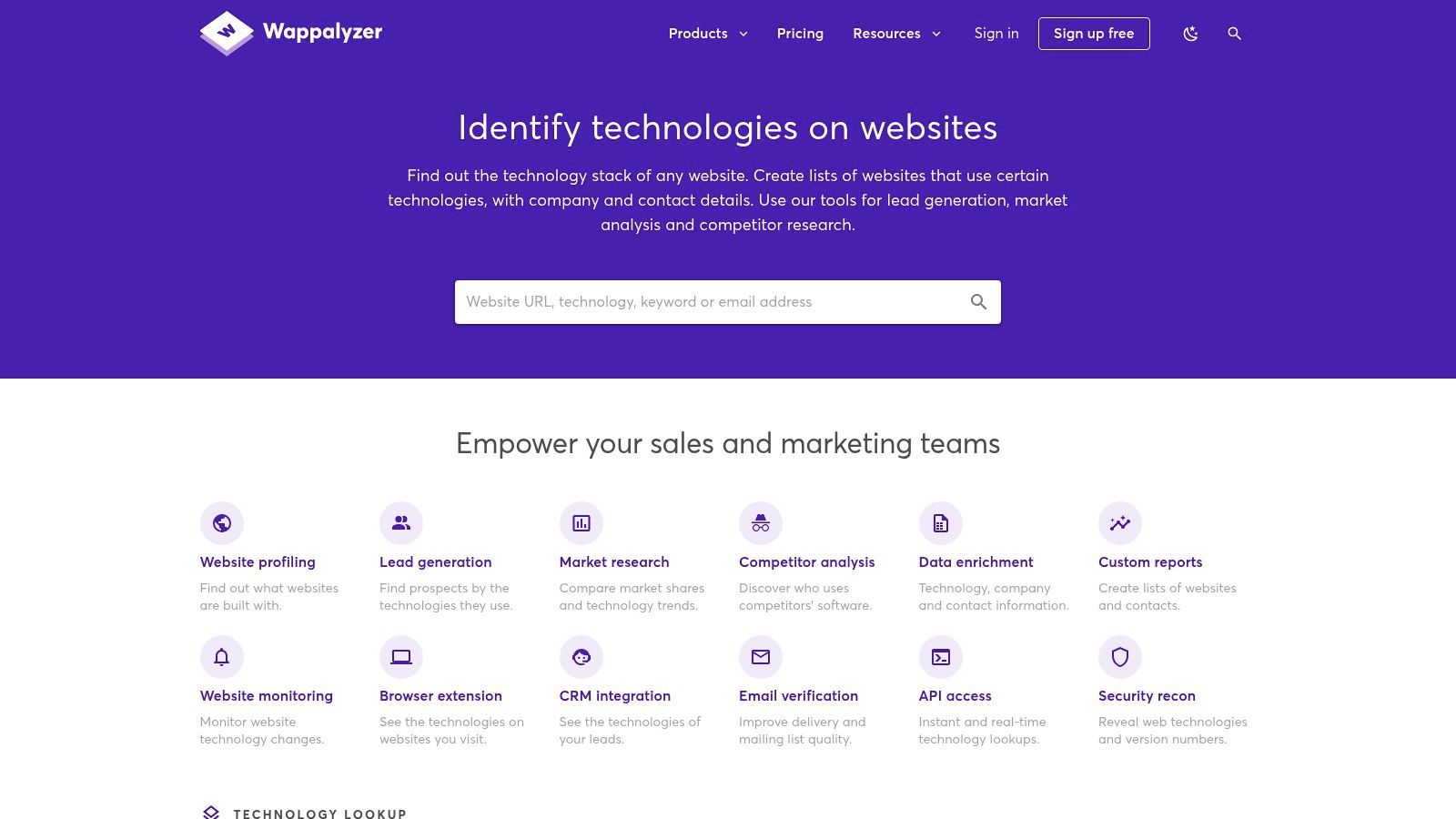
The platform goes beyond simple lookups by allowing you to create alerts that notify you when a competitor adds or removes a specific technology. This real-time intelligence can provide crucial early warnings about strategic shifts, new product integrations, or potential vulnerabilities in their tech stack that you can leverage in your own positioning.
Key Features & Use Cases
- Technology Profiling: Use the browser extension or website lookup to instantly identify the full technology stack of any website. This is perfect for quick, on-the-fly research during sales prospecting or competitor reviews.
- Lead Generation: Build targeted lead lists based on the technologies companies use. For example, find all e-commerce sites using Shopify Plus that don't use a specific live chat tool you offer.
- Market Research: Analyze technology adoption trends across an entire industry to understand which tools are gaining market share and identify potential integration partners.
- Real-Time Alerts: Set up notifications to track when a specific list of companies (like your top competitors) adopts or abandons a particular technology, giving you actionable intelligence.
Pros & Cons
Pros:
- Highly Specific Data: Provides unique insights into a competitor's operational infrastructure that other tools miss.
- Excellent for Sales Prospecting: Invaluable for SaaS companies whose products integrate with or compete against other specific technologies.
- Useful Free Tier: The free browser extension is powerful enough for occasional technology lookups.
Cons:
- Niche Focus: It does not provide any SEO, PPC, or traffic data, making it a supplementary tool rather than a core platform.
- Credit System Can Be Costly: High-volume usage for lead generation or API calls can become expensive.
Website: https://www.wappalyzer.com
11. AppTweak
For businesses where the primary battlefield is the App Store or Google Play, traditional web-based competitor analysis tools fall short. AppTweak fills this critical gap, positioning itself as a leading App Store Optimization (ASO) and mobile intelligence platform. It provides the specific data needed to deconstruct a rival app’s performance, from keyword rankings and creative assets to user sentiment and market share.
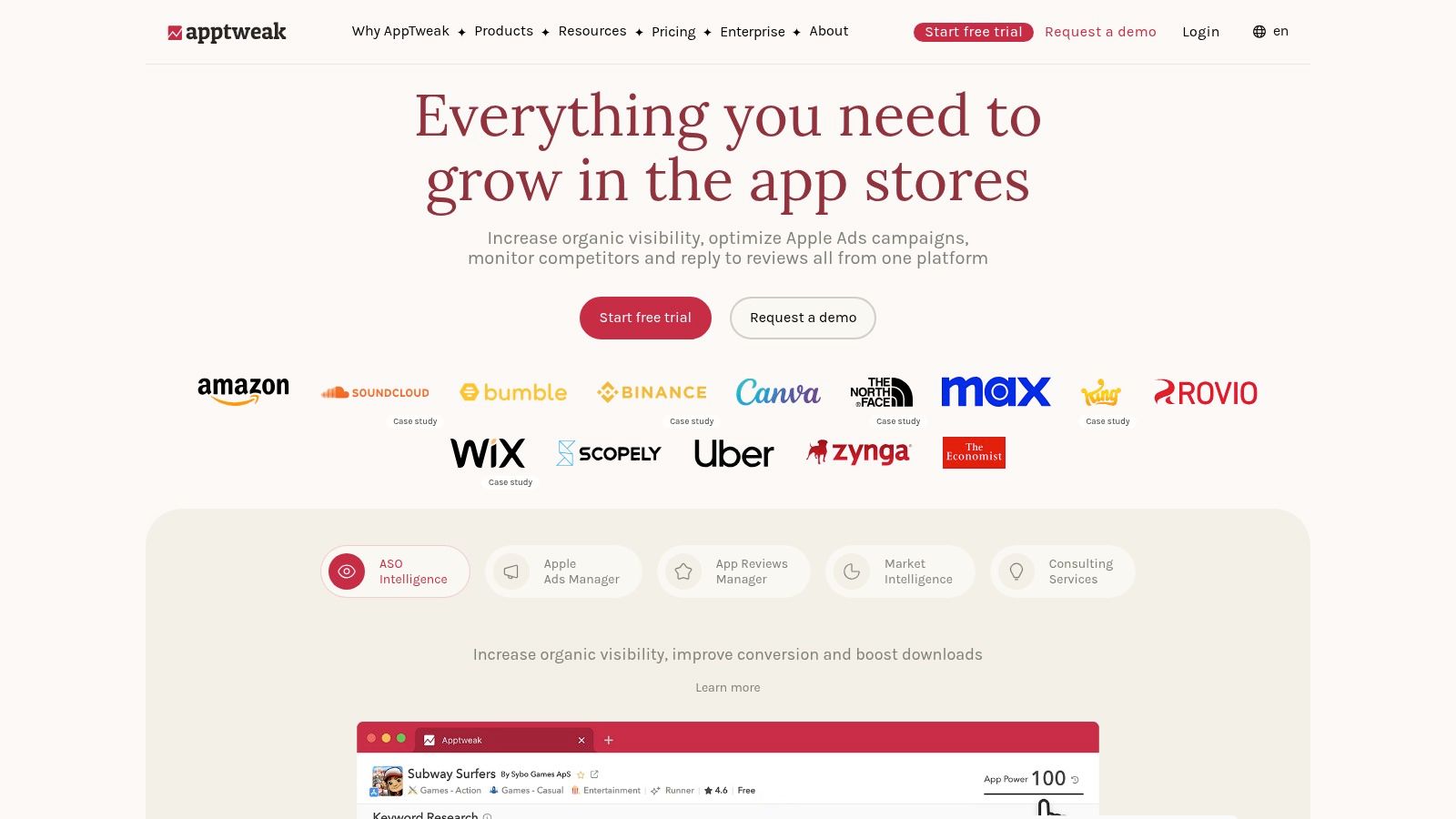
Unlike broad SEO suites, AppTweak is laser-focused on the mobile ecosystem. You can enter a competitor's app to instantly see the keywords they rank for, analyze the effectiveness of their app icon and screenshots, and track their download and revenue estimates. For a SaaS company with a mobile app, this tool is indispensable for understanding how competitors attract and convert users directly within the app stores, making it one of the best competitor analysis tools for any mobile-first strategy.
The platform’s strength is its ability to translate raw data into ASO actions. For instance, you can use its timeline feature to see when a competitor updated their app title or description and correlate that change with a jump in their keyword rankings. This level of granular insight helps you build an evidence-based optimization strategy rather than relying on guesswork.
Key Features & Use Cases
- ASO Intelligence: Uncover the keywords your competitors are targeting and ranking for in both the App Store and Google Play. Monitor their ranking changes over time to spot new opportunities.
- Ad Intelligence: Analyze competitors' mobile ad campaigns, including the creatives they use and the networks they run on, to refine your user acquisition strategy (available in higher tiers).
- Market Intelligence: Benchmark your app's downloads, revenue, and market share against key competitors and the industry as a whole to gauge your market position.
- Review & Sentiment Analysis: Aggregate and analyze user reviews for competitor apps to identify common complaints, feature requests, and points of satisfaction that can inform your product roadmap.
Pros & Cons
Pros:
- Deep Mobile Focus: Provides highly specialized data for the iOS and Android ecosystems that web-focused tools lack.
- Historical Data: Offers extensive historical data for tracking competitor ASO changes and performance over time.
- Actionable Insights: The interface is designed to help users quickly identify and act on optimization opportunities.
Cons:
- Niche Application: Not suitable for analyzing competitors who do not have a mobile app presence.
- Advanced Features Gated: Key intelligence features like ad and deeper market analysis are locked behind more expensive enterprise plans.
Website: https://www.apptweak.com
12. G2 - Competitive Intelligence Software Category
While not a standalone tool, G2's Competitive Intelligence category is an indispensable research hub for any marketer evaluating the best competitor analysis tools. It acts as a meta-resource, a high-traffic software marketplace where you can compare dozens of vendors side-by-side based on authentic, verified user reviews. This shifts the focus from a vendor’s marketing claims to the real-world experiences of its users.
G2's platform allows you to filter and sort tools based on company size, industry, and specific features, helping you quickly create a shortlist of relevant solutions. For a B2B SaaS marketer, this is invaluable for moving beyond well-known names and discovering niche tools that might be a better fit for their specific needs. You can directly compare satisfaction scores, ease of use ratings, and read detailed reviews about implementation and support.
The platform excels at providing social proof and transparency. By cross-referencing feature lists with user-generated pros and cons, you can identify potential red flags or standout benefits that aren't immediately obvious from a vendor's website. It’s the perfect starting point before committing to demos or free trials.
Key Features & Use Cases
- Vendor Shortlisting: Use the Grid reports and category filters to quickly identify the top-rated tools for your market segment (e.g., small business, enterprise) and build an initial list for deeper evaluation.
- Feature & Satisfaction Comparison: Compare up to four tools head-to-head on key metrics like ease of use, quality of support, and specific feature ratings to understand their true strengths and weaknesses.
- Review Analysis: Read in-depth user reviews to understand common use cases, implementation challenges, and the ROI other companies in your industry have experienced.
- Market Trend Discovery: Observe which tools are gaining momentum in the "Leader" or "High Performer" quadrants to understand emerging trends in the competitive intelligence space.
Pros & Cons
Pros:
- Authentic User Feedback: Provides unbiased, verified reviews that offer a realistic picture of a tool's capabilities.
- Excellent for Discovery: Helps you find and shortlist a wide range of tools, including niche players you might otherwise miss.
- Free to Use: Accessing all reviews, comparisons, and reports is completely free for buyers.
Cons:
- Potential for Bias: Sponsored placements can sometimes influence a tool's visibility on category pages.
- Outdated Information: Pricing and feature details listed on G2 may occasionally lag behind the vendor's official website.
Website: https://www.g2.com/categories/competitive-intelligence
Top 12 Competitor Analysis Tools Comparison
Beyond the Dashboard: Turning Competitive Data into Decisive Action
Navigating the competitive landscape of B2B SaaS is no longer a matter of guesswork; it's a data-driven discipline. Throughout this guide, we've explored a powerful arsenal of the best competitor analysis tools, from all-in-one SEO platforms like Semrush and Ahrefs to specialized intelligence solutions like Crayon and Klue. We've seen how tools like BuiltWith can uncover your rival's tech stack and how BuzzSumo reveals the content strategies that truly resonate with their audience. The common thread is clear: visibility into your competitors' strategies is not just accessible, it's essential for survival and growth.
The sheer volume of data these platforms provide can be overwhelming. The true challenge isn't just collecting this information but transforming it into a strategic advantage. A dashboard full of metrics is useless without interpretation and action. Your goal is to move from passive observation to proactive execution, turning competitive insights into measurable improvements in your own marketing, product development, and sales efforts.
From Insights to Impact: Your Action Plan
To make your competitive analysis efforts count, you need a structured approach. The right tool is only the first step; a clear process for implementation and action is what ultimately drives results. Here’s a simple framework to get started:
- Define Your Core Questions: Before you even log into a tool, clarify what you need to know. Are you trying to identify keyword gaps? Understand your competitor's feature launch cadence? Analyze their most successful ad campaigns? Focused questions lead to focused, actionable answers.
- Assign Ownership: Competitive intelligence is a team sport. Designate specific individuals or teams to monitor different areas. Your SEO specialist should own keyword and backlink analysis, your content team should track top-performing articles and social media, and your product marketing team should monitor feature releases and customer reviews on platforms like G2.
- Establish a Rhythm: Don't let competitive analysis be a one-off project. Set up a regular cadence for review, whether it's a weekly check-in on ad copy, a monthly review of content performance, or a quarterly deep-dive into overall market positioning. Use the alerting features in tools like Owler or Crayon to automate this process.
- Translate Data into Action Items: The most critical step is turning findings into concrete tasks. If you discover a competitor is ranking for a high-intent keyword cluster you've ignored, the action item is to create a content brief for a new pillar page. If you see their new feature is getting rave reviews, the action is to schedule a meeting with your product team to discuss its implications.
Choosing Your Competitive Analysis Toolkit
With so many options, selecting the right platform can feel daunting. Your decision should be guided by your specific goals, budget, and team structure.
- For All-in-One SEO & Content: If your primary focus is on organic search, content, and paid ads, comprehensive suites like Semrush or Ahrefs are your best starting point. They provide the broadest set of features for dissecting digital marketing strategies.
- For High-Level Market & Traffic Insights: When you need a quick, big-picture view of a competitor's web traffic, audience demographics, and market share, Similarweb is an invaluable resource.
- For Sales & Competitive Enablement: If your goal is to arm your sales team with real-time battle cards and intel, dedicated competitive intelligence platforms like Klue and Crayon are purpose-built for this task.
- For Granular Technical & Content Insights: For specialized needs, tools like BuiltWith (tech stack), BuzzSumo (content engagement), and SpyFu (PPC history) offer deep, focused analysis.
Ultimately, the best competitor analysis tools are the ones that integrate seamlessly into your workflow and provide clear, actionable intelligence. Don't chase every shiny new feature; focus on the platforms that solve your most pressing business challenges. Start small, master one or two key tools, and build a culture where understanding the competition is a continuous, proactive part of your growth strategy. By doing so, you’ll ensure your business isn't just reacting to the market, but actively shaping it.
Turning competitive insights into a powerful SaaS product that stands out requires more than just data; it demands a flawless user experience. If you’re ready to transform your competitive advantage into an unforgettable product, PimpMySaaS specializes in UX/UI design that converts users into lifelong fans. Visit PimpMySaaS to see how we can help you build a product that not only competes but leads the market.
